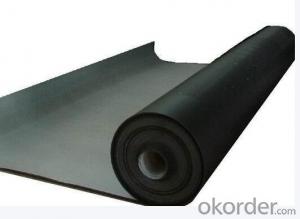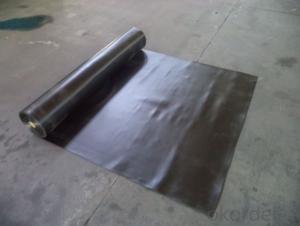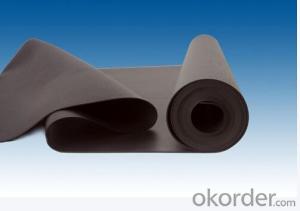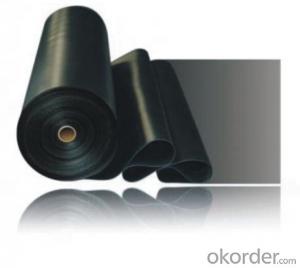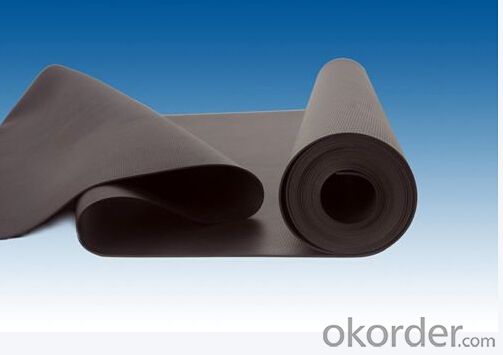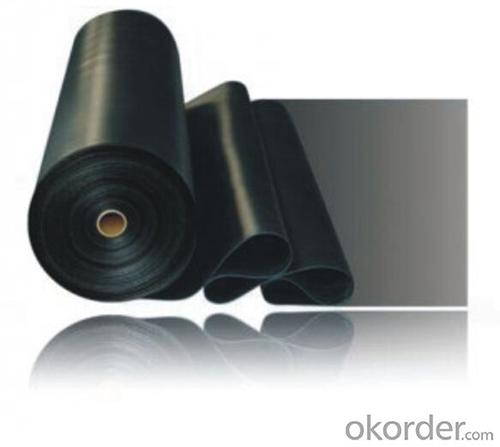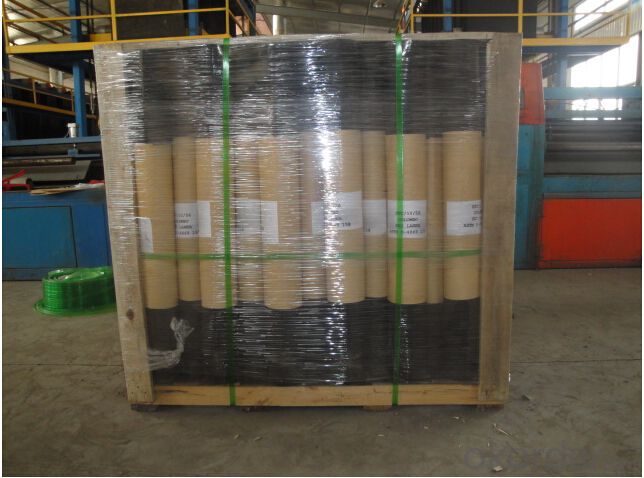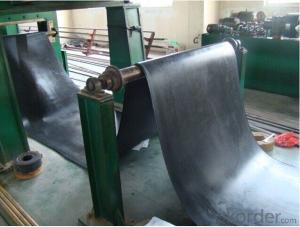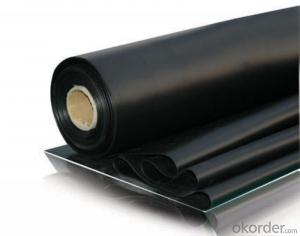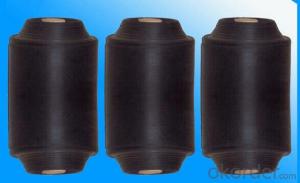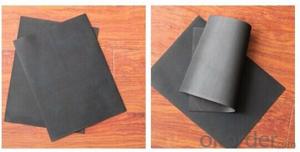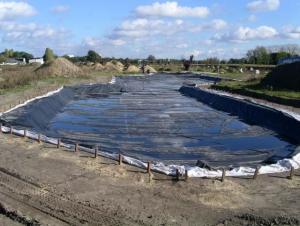Black EPDM Pond Liners For Fish Pond Use
- Loading Port:
- Qingdao
- Payment Terms:
- TT OR LC
- Min Order Qty:
- 2000 m²
- Supply Capability:
- 100000 m²/month
OKorder Service Pledge
OKorder Financial Service
You Might Also Like
EPDM waterproofing roofing membrane
1. Introduction:
EPDM Pond Liners is the modified materials.They are based upon EPDM rubber with modifier,
softener and accelerant assistants added to provide flexibility and stability. Through the precise ingredients, mixing, extrusion, rolling, curing processes, this is made of modified EPDM Waterproofing material with high strength and high flexibility.
2. Specification:
Name | Thickness(mm) | Width(m) | Length(m) |
EPDM | 1.2-2.0 | 2.0-4.0 | 20 |
3. Technical Data:
The item name | Indication | Applicable test items | ||||
Tension Strength (MPa) | Normal temperature≥ | 7.5 | GB6.3.2 | |||
60°C≥ | 2.3 | |||||
Elongation at break | Normal temperature≥ | 450 | ||||
-20°C | 200 | |||||
Tear strength N ≥ | 25 | GB6.3.3 | ||||
(0.3Mpa.30 min)Water tightness | No seeage | GB6.3.4 | ||||
Flexibility at low temperature ≤ | -40 | GB6.3.5 | ||||
Heat expansion (mm) | Extended ≤ | 2 | GB6.3.6 | |||
Contraction ≤ | 4 | |||||
(80°C×168h) | Fracture tensile strength retention %≥ | 80 | GB6.3.7 | |||
Hot air ageing | Keep rate tore elongation | 70 | ||||
%≥ | ||||||
Alkaline [10%Ca(OH)2Normal temperature×168h] | Fracture tensile strength retention %≥ | 80 | GB6.3.8 | |||
Keep rate tore elongation%≥ | 80 | |||||
Ozone aging | — | GB6.3.9 | ||||
Artificial climate ageing | Fracture tensile strength retention %≥ | 80 | GB6.3.10 | |||
Elongation at break %≥ | 70 | |||||
Bond peel strength | Standard test condition | 1.5 | GB6.3. | |||
4. Product Show:
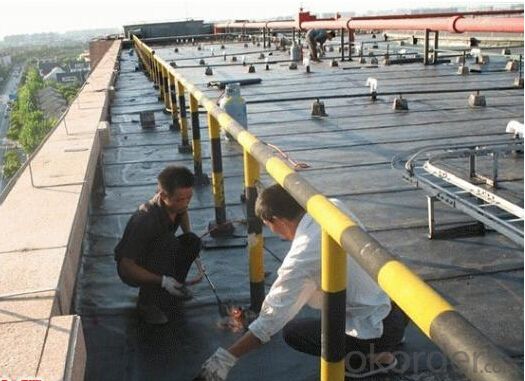
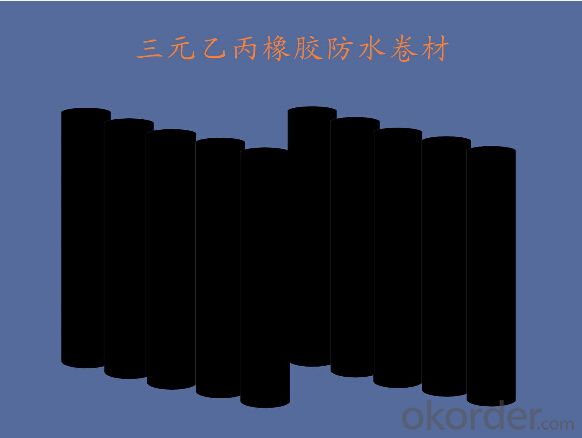
- Q: Can a waterproofing membrane be used in elevator pits?
- Yes, a waterproofing membrane can be used in elevator pits. Elevator pits are prone to water intrusion, as they are located underground and can be exposed to groundwater or other sources of moisture. A waterproofing membrane is a protective layer that is applied to the walls and floor of the elevator pit to prevent water from seeping through. It acts as a barrier and prevents water damage to the structural components of the elevator system, such as the electrical equipment, pumps, and hydraulic systems. By using a waterproofing membrane in elevator pits, the risk of water damage and corrosion can be significantly reduced, ensuring the safe and efficient operation of the elevator.
- Q: Can a waterproofing membrane be used on roofs with skylights?
- Yes, a waterproofing membrane can certainly be used on roofs with skylights. In fact, it is highly recommended to use a waterproofing membrane around skylights to prevent any water infiltration or leakage. Skylights are potential weak points in a roof system, as they create openings that can allow water to seep through if not properly sealed. By applying a waterproofing membrane around the skylights, it helps to create a watertight barrier that protects the roof from any potential leaks. Additionally, a waterproofing membrane can also provide added protection against other elements such as UV rays and temperature fluctuations, prolonging the lifespan of both the skylights and the roof itself.
- Q: Can a waterproofing membrane be used in areas with high foot traffic?
- Yes, a waterproofing membrane can be used in areas with high foot traffic. Waterproofing membranes are designed to provide a protective barrier against water and moisture, making them suitable for various environments, including areas with heavy foot traffic. These membranes are commonly used in commercial buildings, such as shopping malls, hospitals, and office complexes, where foot traffic is frequent. However, it is important to choose the right type of waterproofing membrane that is specifically designed for high foot traffic areas. Some membranes are more durable and resistant to wear and tear, making them ideal for such environments. Additionally, proper installation and maintenance of the membrane are crucial to ensure its longevity and effectiveness in high foot traffic areas. Furthermore, it is worth considering the specific requirements of the area and consulting with professionals or manufacturers to determine the most suitable waterproofing membrane for the given conditions. Overall, with the right selection and proper installation, a waterproofing membrane can effectively protect areas with high foot traffic from water damage and ensure their longevity.
- Q: Can a waterproofing membrane be applied on top of roofing materials?
- Yes, a waterproofing membrane can be applied on top of roofing materials. It is common practice to install a waterproofing membrane on top of roofing materials to provide an additional layer of protection against water infiltration and extend the lifespan of the roof.
- Q: Can a waterproofing membrane be used for a green roof system?
- Yes, a waterproofing membrane can be used for a green roof system. In fact, a high-quality waterproofing membrane is an essential component of a green roof system. Green roofs are designed to support the growth of vegetation and require a durable and reliable waterproofing barrier to prevent water leakage and protect the underlying structure from moisture damage. A waterproofing membrane acts as a protective layer, effectively sealing the roof and preventing water from penetrating into the building. Additionally, the membrane helps to retain water within the green roof system, ensuring that the plants receive an adequate water supply. Therefore, integrating a waterproofing membrane into a green roof system is crucial for its success and longevity.
- Q: Does a waterproofing membrane require any specific preparation of the substrate before installation?
- Preparation of the substrate is essential for the installation of a waterproofing membrane. Before applying the membrane, the surface on which it will be placed must be thoroughly cleaned, dried, and devoid of any contaminants or debris that could impede its adhesion. This process typically entails the removal of loose materials, such as old paint or sealants, and the leveling of any uneven surfaces. Furthermore, it may be necessary to repair any cracks or damage in the substrate to guarantee a proper and efficient installation of the waterproofing membrane. By following the recommended preparatory procedures, one can ensure that the membrane performs optimally and exhibits remarkable durability, effectively safeguarding the underlying structure against water infiltration.
- Q: Are there any specific maintenance requirements for a waterproofing membrane?
- Yes, there are specific maintenance requirements for a waterproofing membrane. Regular inspections should be conducted to check for any signs of damage or deterioration, such as cracks or leaks. Any debris or standing water should be promptly removed to prevent potential damage. Additionally, it is important to follow the manufacturer's guidelines for cleaning and maintenance, which may include periodic cleaning with mild detergents and avoiding the use of harsh chemicals or abrasive cleaning tools.
- Q: How to distinguish the degree of sbs waterproofing membrane?
- Method 1: Look at the product packaging instructions or factory inspection report, if it is type Ⅰ coil, low temperature flexibility is -20 °, if it is type Ⅱ coil, low temperature flexibility is -25 °.
- Q: Are waterproofing membranes resistant to acid rain?
- Yes, waterproofing membranes are generally resistant to acid rain due to their ability to protect against water penetration and chemical exposure.
- Q: Can a waterproofing membrane be used on terraces or patios?
- Terraces and patios can benefit greatly from the application of a waterproofing membrane. To avoid water damage and leakage, it is highly recommended to use this protective layer in these areas. Given that terraces and patios are exposed to different weather conditions, such as rain and snow, moisture can easily seep into the underlying structure. To counteract this issue, a waterproofing membrane acts as a barrier, preventing water from infiltrating the surface and safeguarding the integrity of the terrace or patio. This solution not only extends the lifespan of the structure but also prevents costly repairs in the future. Moreover, the use of a waterproofing membrane contributes to the creation of a more comfortable and functional space, as it eliminates the risk of water accumulation and potential slip hazards. All in all, investing in a high-quality waterproofing membrane is a wise choice for those seeking to protect their terrace or patio from water damage.
Send your message to us
Black EPDM Pond Liners For Fish Pond Use
- Loading Port:
- Qingdao
- Payment Terms:
- TT OR LC
- Min Order Qty:
- 2000 m²
- Supply Capability:
- 100000 m²/month
OKorder Service Pledge
OKorder Financial Service
Similar products
Hot products
Hot Searches
Related keywords
